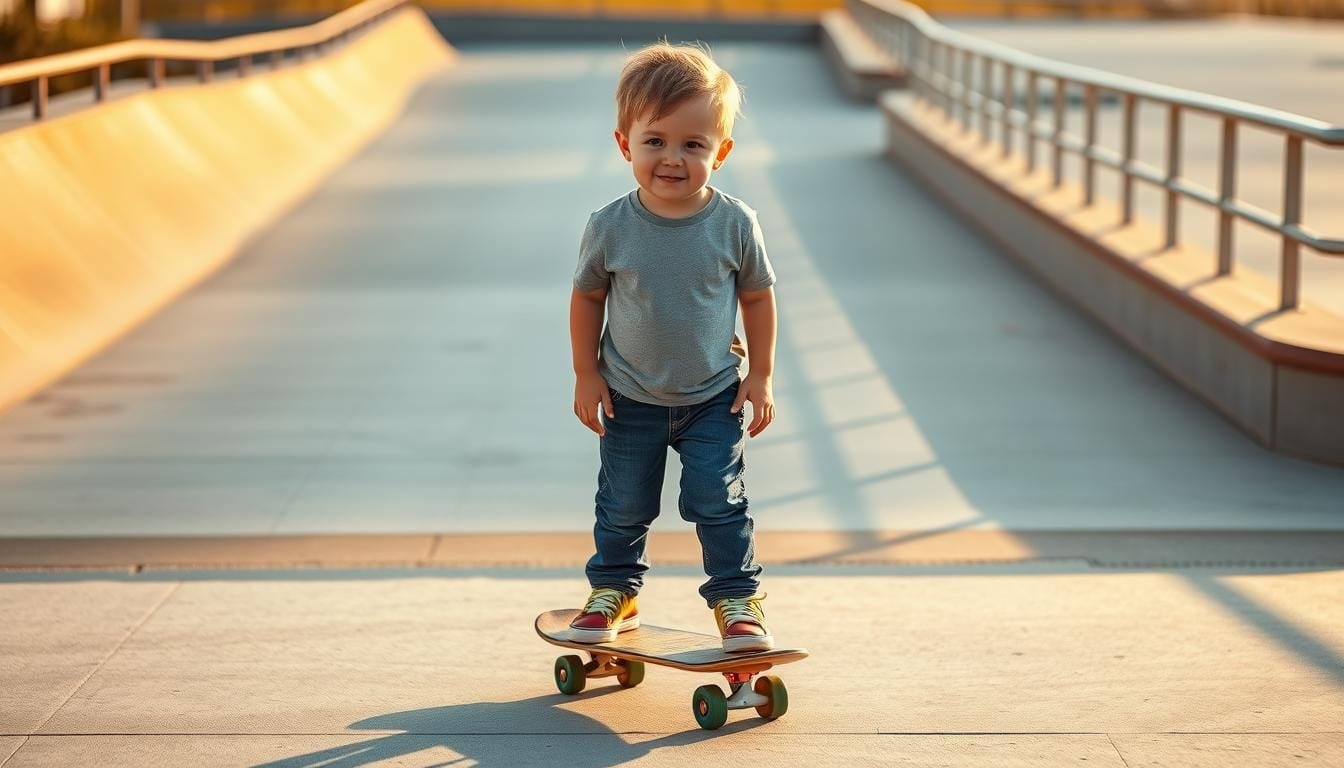Skateboarding is a fun sport that many people love. But it’s vital to know when to start skateboarding to be safe and have fun learning. Experts and professional skateboard instructors often say kids should start at about 7 years old. This is because kids this age are developing their motor skills. They’re also learning to follow basic safety rules with someone to guide them.
A lot of pros believe the ideal age to start skateboarding is between 7-12 years old. This time is perfect because kids can safely get better at skateboarding while the risk of getting hurt is low. Starting within this age range helps kids get good at the basics of skateboarding. It also teaches them to keep trying and not give up.
Knowing the best time to start skateboarding for yourself or your child is key. This skateboarding age guide goes into more detail to give you a clear plan. It covers everything from choosing the right equipment to slowly getting better at skateboarding skills. Starting at the right age can spark a lifelong love of skateboarding.
Key Takeaways
- The recommended age for starting skateboarding is around 7 years old.
- The sweet spot for beginning skateboarding is often cited as 7–12 years.
- Important to use proper safety gear, including helmets, knee pads, and elbow pads.
- Early exposure to skateboarding enhances agility and proprioception in young skaters.
- Understanding the right starting age ensures both safety and enjoyment in skateboarding.
Understanding Skateboarding Abilities Across Age Groups
Skateboarding is a lively sport loved by all ages. But, your skills can change as you get older. This change is due to coordination, balance, and how well you move. We’ll look at how these skills grow at different ages.
Children around 7 years old start to learn skateboarding basics. This recommendation comes from many skateboarding instructors. Early exposure helps them get quicker and more agile. Still, it might be smart to wait until they’re 8-10 for regular practice.
By then, kids are better at moving and understanding risks, which lowers the chance of getting hurt. Studies show that the best age to start skateboarding is between 8 and 12. This ensures they learn well without getting injured.
Teenagers find it easy to pick up skateboarding. They learn quickly and start taking smart risks. This helps them get better at skateboarding. Practicing a lot during these years improves their balance and coordination. These are key for doing advanced skateboarding tricks.
Adults think more about their skateboarding strategy. They may not be as quick as kids, but they avoid injuries by being careful. They focus on how they skate and keeping control. It’s also very important for them to wear the right safety gear.
Knowing how skateboarding skills change with age helps you or your kids enjoy skateboarding. It makes sure you stay safe and keep getting better at different levels of skateboarding.
The Ideal Starting Age for Children
Figuring out the best skateboarding age for kids is key for their safety and fun. The American Academy of Pediatrics says kids under 5 should not skateboard. This is because they’re small and could get hurt easily. But kids between 5 and 10 years old are in a good spot to start. This is when their balance and body control get better.
Kids as young as 3-4 years can begin skateboarding with an adult watching and the right safety gear. At first, they learn to push and stay upright on the board. For those 4-5 years old, these first steps are crucial. By 6, some kids may start doing simple tricks, though each child grows at their rate.
It’s also critical to check if your kid is mentally ready for children skateboarding. Make sure they understand how to stay safe and really want to learn. Having someone to watch them and keep them safe as they get better is important.
The perfect time to start skateboarding varies for every kid. Looking at their physical and mental readiness helps make it fun and safe. Supporting your kid in these early times can help them fall in love with skateboarding forever.
Benefits of Starting Young
Skateboarding young offers many perks. It’s not just about tricks. It helps with physical, mental, and social growth. This makes it a top pick for kids.
Skateboarding can really boost a kid’s physical health. It works out different muscles like in the feet, legs, arms, and torso. Kids become stronger and more flexible.
It’s also great for motor skills and coordination. starting at ages 8-12 is best. It helps them avoid injuries and get better at judging risks. Early skateboarding can make reflexes quicker and improve agility.
Skateboarding does wonders for the mind too. It teaches the value of practice and not giving up. Failing and trying again builds confidence and resilience. These are great skills for life.
It also helps kids make friends. Skate parks are where they can meet others and learn from them. This improves social skills and teamwork.
But safety first, right? Wearing helmets, knee pads, and elbow pads is a must. Kids need an adult watching until they know the safety rules well.
So, skateboarding young has lots of benefits. It makes kids fit, teaches life skills, and helps them make friends. It’s really worth trying.
Skateboarding for Teens: A Great Time to Start
Teen skateboarding is more than just fun. It’s a great way for young people to grow in many ways. Teens are getting stronger every day. Skateboarding is a perfect sport to make the most of that strength. It improves your balance, coordination, and control.
It also sharpens your brain. Skateboarding challenges teens to solve problems and stay focused. Learning to ride on different surfaces and performing tricks boosts your thinking skills. It also makes you better at making quick decisions. Plus, skateboarding introduces teens to new friends. Hanging out at skate parks brings teens together, creating lasting friendships and a strong community feeling.
Skateboarding also lets teens express themselves. It offers freedom to be creative on and off the board. Choosing how to decorate your skateboard or mastering a cool trick are ways to show off your creativity. With endless possibilities, skateboarding during the teen years is truly fulfilling.
| Aspect | Benefits |
|---|---|
| Physical Strength | Enhances coordination, balance, and control |
| Cognitive Development | Improves problem-solving skills and decision-making abilities |
| Social Engagement | Fosters friendships and community connections |
| Creativity | Serves as an outlet for artistic expression |
Starting Skateboarding as an Adult
Think it’s too late to start skateboarding as an adult? Think again. It’s a sport that isn’t just for the young. Adults find skateboarding is a top-notch workout. It boosts balance, coordination, and heart health. Plus, it’s a great way to relieve stress and feel accomplished.
Jumping into adult skateboarding, you’ll find a community that’s welcoming and supportive. Take the ‘Sisters of Shred’, for instance—a group of 50-plus moms on boards, doing tricks. And Steve Caballero, still skating at 61, shows age is just a number in this lively community.
Adult skateboarding is also perfect for connecting with people who share your interests. It’s becoming popular among those in their 20s and 30s. These folks are revisiting their youthful passions, which adds excitement to their lives. If you’re looking to start, you’ll be in great company. Many resources and fellow skaters are there to help you.
Look at Neal Unger, for example, one of the oldest skateboarders. He approaches skateboarding with a spiritual mindset. It shows the sport is about more than just skill. Plus, don’t worry about being a newbie. Skateparks are less crowded at non-peak times, so it’s easier to learn.
For tips on the best age to start, check this article from Board Blazers. You’ll see that skating is for everyone, no matter your age. The excitement and the chance to learn new things make it a great choice for adults.
Starting skateboarding as an adult opens up a world of benefits. It’s not just about staying fit. It’s a chance to join an energetic community that enriches your life.
Tips for Choosing the Right Skateboard
Choosing the right skateboard is key for a fun and safe ride. Looking at a skateboard buying guide helps, especially for you or your child. Think about age, size, and skill level.
For kids 3 to 5, mini-cruisers are best. They’re 22-27 inches long and easy for young kids to control. Kids 5 to 8 should move to wider decks, 28-32 inches, to learn skateboarding basics.
Kids 8 to 12 often move to 30-33 inch standard popsicle decks. These are great for tricks. Once they hit 12, deck sizes should be 31-33 inches, based on their style.
Width is also key for the right skateboard. For kids, it ranges from 6.5 to 8 inches. Pick based on foot size and preference. Over 60% of skate injuries are from wrong board sizes. A free skateboard size calculator can help pick the right size based on shoe size, age, and skill.
Don’t forget about quality. A good skateboard has a 7-ply maple wood deck. Cheap boards often skip quality materials like Canadian maple. This affects how long it lasts and how well it performs.
Supporting local skate shops is a good move. They offer quality boards and advice. They might cost about $10 more than big stores like Walmart, though.
| Age Group | Deck Length | Recommended Type |
|---|---|---|
| 3-5 years | 22-27 inches | Mini-cruisers |
| 5-8 years | 28-32 inches | Standard deck |
| 8-12 years | 30-33 inches | Standard popsicle deck |
| 12+ years | 31-33 inches | Based on riding style |
Choose a skateboard that fits well to improve skills and keep safe. This guide makes picking one less overwhelming and more fun.
Encouraging a Lifelong Passion for Skateboarding
Skateboarding can become more than a hobby; it can be a rewarding part of life. Highlighting the sport’s mental health benefits is vital. It’s known that 85% of skateboarders feel less anxious and more mentally fit. Showing skateboarding as both fun and a way to better oneself can keep people skating longer.
Being part of a community helps keep the skateboarding spark alive. “Gnarly Mums” connects skateboarding moms, creating a strong support network. The number of female skateboarders has grown, partly thanks to Sky Brown’s Olympic success. When family and friends join in, it’s even better. In fact, 65% of skateboarding parents say their kids are more likely to start skating after watching them.
Learning new skills keeps the excitement in skateboarding. Newcomers often start with longboards for better stability. Plus, taking skateboarding lessons can quicken learning by 50% over going at it alone. This approach boosts self-esteem and encourages setting and reaching goals.
To discover the best age to begin skateboarding and gain more knowledge, check out this informative guide. The skateboarding world is filled with adventures and new friends. By focusing on constant improvement, community engagement, and personal health, you’re paving the way for a lifelong journey in skateboarding.

I’m John Peterson, a passionate skater, blogger, and lifelong enthusiast. I’ve been skating for over 9 years and have gone on to write a blog dedicated to the sport of skating and its culture. Through my blog, I strive to share my knowledge and experience of the sport with all who are interested. From beginner tips, tricks, and equipment reviews to interviews and event coverage, I cover it all. So read my blog as I explore the wonderful world of skating!

